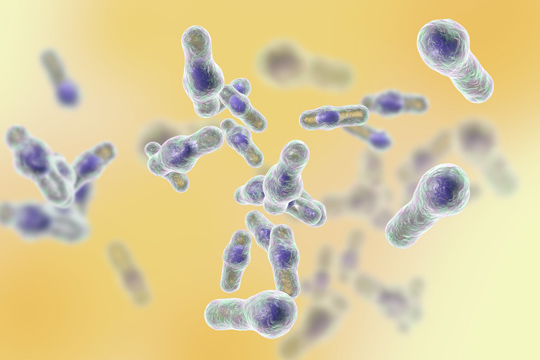Neatly-folded toxins
Freiburg, Sep 27, 2018
Clostridium difficile can have devastating effects when the poisons it produces destroy the barrier function of intestinal mucosa. Researchers headed by the Freiburg pharmacologist Professor Dr. Dr. Klaus Aktories has found out exactly how the toxins enter cells and take effect there.

The Clostridium difficile germ spreads its spores. Some 20 percent of patients in hospitals are affected by it. Photo: Kateryna Kon/Fotolia
Diarrhea? Well - it’s unpleasant, but fortunately harmless. Not always, says Klaus Aktories. A researcher at the Institute of Experimental and Clinical Pharmacology and Toxicology, he cites the case of an elderly patient who is admitted to hospital with severe pneumonia - and has to take antibiotics. “But the antibiotics attack the microbiome in the gut, popularly known as the ‘good bacteria,” Aktories explains. “They destroy the bacteria - and then fail to keep another bacterium in check.”
Clostridium difficile is the name of this germ, which can spread by spores. Some 20 percent of patients in hospitals are affected by it. It is the bacterium which causes the diarrhoea which in some cases can even lead to a particular form of severe inflammation of the intestine. “There is a lot we can do to stop it,” says Aktories. In other cases there may be complications - with often fatal consequences. Up to 30,000 deaths per year are ascribed to Clostridium difficile annually in the United States alone.
Aggressive strains
“The problem is getting worse, because in the past 20 years, particularly aggressive versions of the germ have spread quickly,” Aktories warns, citing an article in the January 2018 edition of the medical journal “Ärzteblatt.” The article’s author quotes a theory, supported by US studies, that the increased use of the industrially-produced disaccharide Trehalose promotes the spread of the aggressive Clostridium difficile germs. The devastating effect of Clostridium difficile is due to its toxins A and B. “They don’t always activate, we don’t know why,” Aktories says. But certainly “there can be no disease without the toxins. We’ve known that for a long time.”
We have also long known what the toxins do - “We worked out the molecular mechanism of these toxins back in the 1990s. It penetrates the cells, transfers sucrose onto a protein switch, rendering it inactive.” The mucosal surface loses its barrier function as a result. Aktories, his team, and his colleague from Würzburg, Professor Andreas Schlosser, have found out exactly how the toxins enter cells and take effect there.

Case study: An elderly patient is admitted to hospital with severe pneumonia; the doctor prescribes him an antibiotic – that kills off the good bacteria in his bowel and creates ideal conditions for Clostridium difficile to establish itself. Photo: Gorodenkoff/Fotolia
Absorption of the toxins depends on a complex protein called TRiC/CCT. TRiC/CCT is what’s called a chaperonin, which serves other proteins - including protein switches. It helps them to “fold” proteins - ensuring they can function properly. “TRiC/CCT reacts with the toxins produced by Clostridium difficile,” Aktories explains. Once the toxin has entered the cell, there is interaction between the toxin and the chaperonin, giving the toxin the right shape and enabling it to become active.
On to the next steps
The researchers’ findings do not automatically mean that they have found a way of switching off the poison created by Clostridium difficile. The toxic effects do stop when the chaperonin is blocked. “But that is not yet possible in treatment; the function of TRiC/CCT is too complex and it is vital to the cell,” Aktories adds. Yet the findings make the first steps possible: “We now know much more about how cells take in the toxin-producing proteins - and how they are folded.”
It took one and a half years to get this far. Do the champagne corks start popping when researchers make a breakthrough like this? “Not really until the report about it has been publicly accepted,” Aktories laughs. That has now happened. The study has been published in the respected journal, Proceedings of the National Academy of Sciences. Aktories is especially happy “that we were able to finish this together.” He is retiring at the end of September 2018.
Mathias Heybrock

